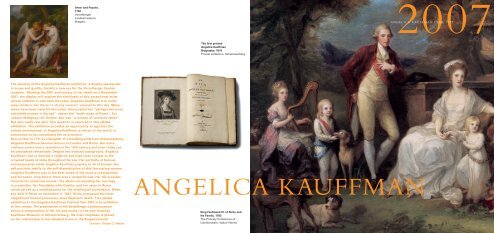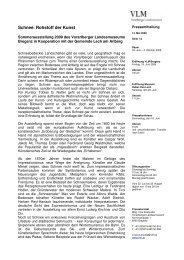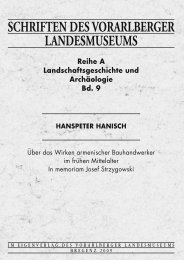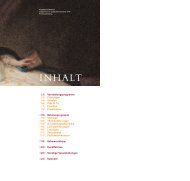ANGELICA KAUFFMAN
ANGELICA KAUFFMAN
ANGELICA KAUFFMAN
Create successful ePaper yourself
Turn your PDF publications into a flip-book with our unique Google optimized e-Paper software.
Amor and Psyche,<br />
1792<br />
Vorarlberger<br />
Landesmuseum,<br />
Bregenz<br />
The opening of the Angelica Kauffman exhibition, a display spectacular<br />
in scope and quality, heralds a new era for the Vorarlberger Landesmuseum.<br />
Marking the 200 th anniversary of her death on 5 November<br />
2007, the display will explore the timeliness of this exceptional artist,<br />
whose radiance is unbroken till today. Angelica Kauffman is in many<br />
ways modern, her life as “a strong woman” unusual to this day. Many<br />
terms have been used for this artist. Some called her “perhaps the most<br />
cultivated woman in Europe”, others the “tenth muse of Rome”. For<br />
Johann Wolfgang von Goethe, she was “a woman of immense talent”.<br />
But who really was she? This question is explored in this jubilee<br />
exhibition. The exhibition provides an opportunity to appraise the<br />
artistic development of Angelica Kauffman, a citizen of the world, in<br />
connection to her remarkable life as a woman.<br />
Born in Chur in 1741 as a daughter of a travelling artist from Schwarzenberg,<br />
Angelica Kauffman became famous in London and Rome. Her extraordinary<br />
career was a sensation in the 18th century and even today can<br />
be considered remarkable. Despite her ordinary background, Angelica<br />
Kauffman rose to become a celebrity and kept close contact to the<br />
crowned heads of state throughout Europe. Her portraits of famous<br />
contemporaries made Angelica Kauffman popular in all of Europe. Her<br />
self-portraits testify to the self-dramatization of this fascinating woman.<br />
Angelica Kauffman was in the best sense of the word a cosmopolitan<br />
and European, long before there was a united Europe. Her life provides<br />
material for numerous novels: the affairs surrounding her marriage<br />
to a swindler, her friendship with Goethe, and her salon in Rome<br />
which served as a meeting point for the intellectual prominence. When<br />
she died in Rome on November 5, 1807, Rome witnessed the most<br />
magnificent funeral procession since Raphael’s death. This jubilee<br />
exhibition in the Angelica Kauffman Festival Year 2007 is an exhibition<br />
at two venues: The presentation in the Vorarlberger Landesmuseum<br />
shows a compendium of her life and works; in the new Angelica<br />
Kauffman Museum in Schwarzenberg, the main emphasis is placed<br />
on her relationship to her adopted home in the Bregenzerwald.<br />
Curator: Tobias G. Natter<br />
The first printed<br />
Angelica Kauffman<br />
Biography, 1810<br />
Private collection, Schwarzenberg<br />
Angelika Kauffmann machte als Frau in ihrer Zeit eine außergewöhnliche<br />
Karriere. Die Künstlerin mit Wurzeln im Bregenzerwald begeisterte schon<br />
die Zeitgenossen durch ihr Werk und faszinierte mit ihrer Lebensgeschichte.<br />
Das Vorarlberger Landesmuseum in Bregenz baute im Laufe<br />
seiner 150-jährigen Geschichte die umfangreichste Angelika-Kauffmann-<br />
Sammlung weltweit auf.<br />
<strong>ANGELICA</strong> <strong>KAUFFMAN</strong><br />
King Ferdinand IV. of Sicily and<br />
his Family, 1783<br />
The Princely Collections of<br />
Liechtenstein, Vaduz-Vienna<br />
2007<br />
A N G E L I C A K AU F F M A N Y E A R 2 0 0 7









